Hong Kong protest: Airport ban draws line in the sand
HK authorities have banned further demonstrations at airport, setting the scene for a potential all or nothing clash.
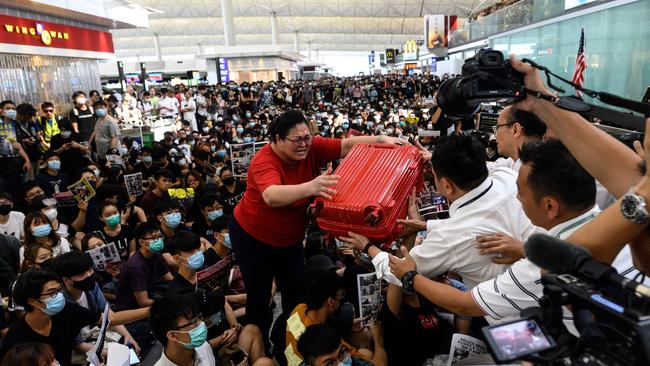
Hong Kong authorities have banned further demonstrations at the city’s international airport, setting the scene for a potential all or nothing clash with protesters.
The Airport Authority drew a line in the sand after pro-democracy protesters caused another night of chaos, effectively shutting down the airport. Late on Tuesday night, the AA obtained an injunction order prohibiting further demonstrations and stopping people from “wilfully obstructing or interfering with the proper use of the airport,” the South China Morning Post reports.
“The interim injunction expressly provides that nothing in the interim injunction shall be construed as authorising any demonstration, protest or public order event contrary to the Public Order Ordinance, ” the authority said in a statement this morning.
The order was published as Beijing ramped up its rhetoric against the protesters, accusing them of trying to bring about regime change in Hong Kong. Comparing the weeks long protests with the “colour revolutions” of the Arab spring, the pro-Beijing newspaper Global Times claimed the protests had evolved into “an attempt to .. reshape the city’s power structure.”
“Political opposition and protesters have integrated and Western forces have offered them various forms of assistance and support,” the newspaper claimed.
Amid China’s hardening attitude, Beijing denied access to Hong Kong port for two US Navy ships due to visit the city, and warned of the ”Black Hand” of American interference in the increasingly violent protests.
This morning Commander Nate Christensen, deputy spokesman for the United States Pacific Fleet, said two vessels had been barred from the port.
“The Chinese government denied requests for port visits to Hong Kong” by USS Green Bay, an amphibious dock landing ship, which was to stop in Hong Kong on Saturday, and guided missile cruiser USS Lake Erie due there next month.
Commander Christensen referred the question of why the request was denied to China. The last US Navy visit to the citiy was last April.
MORE: Gottliebsen — What is our Hong Kong plan? | Commentary — Behind Beijing’s push | Fears of a new Tiananmen no longer absurd
China’s decision came hours after Donald Trump said China was moving troops to the city’s border, without citing specific evidence.
“Our Intelligence has informed us that the Chinese Government is moving troops to the Border with Hong Kong,” the president tweeted. “Everyone should be calm and safe!”
Our Intelligence has informed us that the Chinese Government is moving troops to the Border with Hong Kong. Everyone should be calm and safe!
— Donald J. Trump (@realDonaldTrump) August 13, 2019
Social-media accounts run by Chinese news outlets published footage Monday of mainland paramilitary police forces arriving in the southern city of Shenzhen, which abuts Hong Kong.
As police with shields and batons tried to arrest protesters jammed into the airport’s departures area, they responded by throwing bottles and projectiles.
Late on Tuesday, demonstrators seized two men they suspected of being pro-Beijing infiltrators, with witnesses saying they were beaten and tied to luggage trolleys. In both cases, paramedics had to struggle to extract them from the crowd.
“Everything is out of control right now,” said Jamie, a 21-year-old protester. “This movement doesn’t have a leader; everyone does what they want.” The rapid escalation into violence shows how volatile the protests are becoming as controlled decision-making gives way to a mob mentality. Hong Kong authorities have begun to crack down more severely on the protesters, with business leaders and officials offering stronger support to quell the unrest as it starts to damage Hong Kong’s economy and its global reputation as a safe place to do business.
In a morning news conference, the city’s leader, Carrie Lam choked back tears and warned protesters were dragging Hong Kong into “the abyss.” On mainland China’s Twitter-like microblogging service Weibo, users showed footage of one of the men who had been beaten in which he appeared to be unconscious and breathing through an oxygen tube. The airport violence was a heavily searched topic on Weibo, with many users expressing shock and anger at the assault.
In comments to reporters earlier on Tuesday, Mr Trump called the developments in Hong Kong a “very tough situation” and said he hoped nobody would be hurt or killed. “I hope it works out for everybody, including China, by the way,” the president said.
As per a request for assistance from the Airport Authority, the Police appeal to the protestors to stop their obstruction so that the visitor can receive timely medical attention.
— Hong Kong Police Force (@hkpoliceforce) August 13, 2019
The Police stress that this is not a dispersal operation and aim to escort the visitor safety to a hospital.
— Hong Kong Police Force (@hkpoliceforce) August 13, 2019
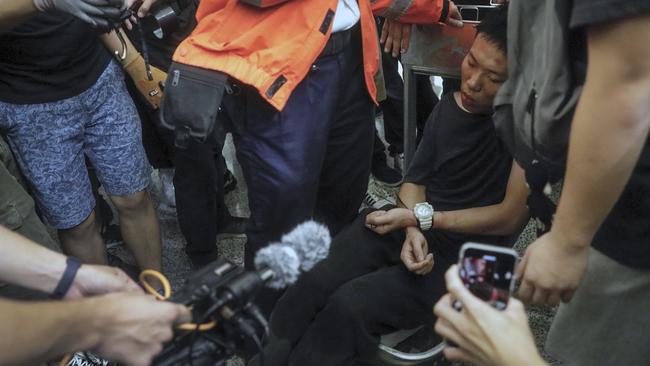
A senior administration official said the US believed Chinese military intervention in Hong Kong would depend on whether Beijing determined that local authorities had lost control of the crisis.
Meanwhile, Secretary of State Mike Pompeo and China’s most senior foreign-policy official, Yang Jiechi, met in New York Tuesday morning. While the State Department didn’t reveal any details of the conversation, spokeswoman Morgan Ortagus said the two officials “had an extended exchange of views on US-China relations.”
At the airport, the day began with small numbers of black-clad and often masked protesters dotting the arrival hall, some playing the violin and singing. It ended with fierce fights, including one in which protesters grabbed an officer’s baton and began beating him with it until he pulled his gun and they ran off.
The airport suspended all check-in activity and advised people not to travel there as the protesters’ numbers swelled quickly late in the afternoon. Travellers who tried to pick their way through the crowds were shouted down and cursed at by protesters. A few passengers managed to push their way through.
The mood turned uglier in the evening as protesters turned on a young man among them whom they suspected of being an undercover police officer. Protesters searched his pockets and said they found an identification card bearing a name matching one in an online database of police officers in Shenzhen.
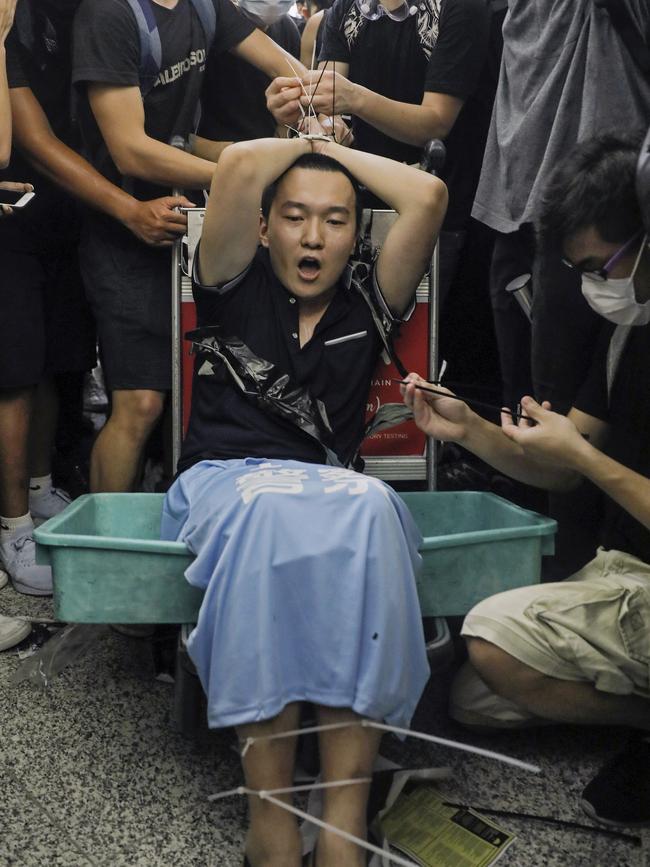
At one point, some protesters suggested they would let the man go but others dissented. A handful of airport officials attempted to intervene but were rebuffed. A small group of protesters tied the man up and shuffled him around the stiflingly hot airport hall for three hours, chanting “Bear the consequences.”
Later in the evening a second man was seized by protesters and accused of being in league with the police. Although he was wearing a press jacket, protesters said he acted suspiciously. They detained him and emptied his bags, finding a blue shirt emblazoned with a slogan supporting the police, and a business card of a member of a pro-Beijing organisation.
Protesters surrounded him and beat him, as he lay on the floor. The editor in chief of the Global Times, a pro-government Chinese tabloid, tweeted that the man was a reporter with the paper and asked the protesters to release him. A team of medics made their way to the injured man, who was hauled onto a stretcher and carried out to a waiting ambulance.
Hong Kong’s airport presents an easy target for demonstrators. Its open design admits large numbers of people quickly and efficiently, and the city prides itself on the ease of access. In addition to cabs, there are frequent buses as well as express trains that run every 10 minutes and take less than half an hour to make the trip from the city centre.
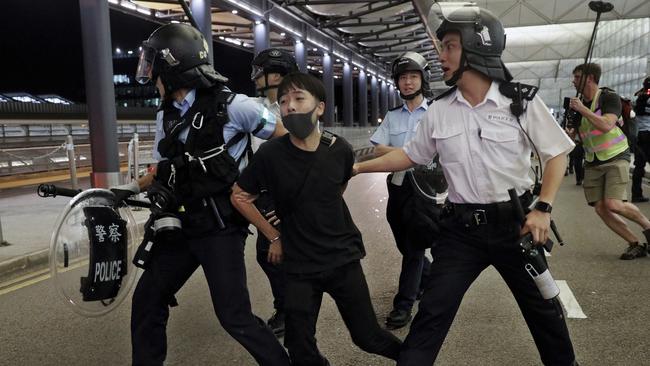
Airport authorities implemented new restrictions early onTuesday, requiring travellers to show proof of their bookings before letting them into the check-in area. The arrival of protesters in greater numbers by the afternoon overwhelmed those efforts.
“The police have correspondent measures to support the airport authority in monitoring the situation, and we’ll pay attention to the acts of these protesters and whether there is any breach of the peace inside the airport,” a police spokesman said at a news conference before the situation deteriorated.
Tuesday’s disruptions were a further blow to Cathay Pacific, Hong Kong’s flag carrier, which has come under heavy pressure from China over employees who join the protesters.
On Monday, the airline said it would fire staff who participated in unauthorised protests. On Tuesday, parent company Swire Pacific said it shared the Chinese government’s view of the city’s future and condemned what it called illegal acts that threatened the “one country, two systems” principle under which Hong Kong maintains some autonomy under Chinese rule.
“We resolutely support the Hong Kong SAR Government, the Chief Executive and the Police in their efforts to restore law and order,” Swire said in a release.
Cathay’s shares fell 2.6% Tuesday.
An overwhelming turnout a day earlier forced the airport to halt all outbound flights. The airport was still contending with those cancellations Tuesday, with hundreds of morning and afternoon flights taken off the board and dozens of others delayed.
Protesters waved posters depicting alleged police brutality and chanted pro-democracy slogans.
“Protesting in the airport is the best way to tell the world what’s happening in Hong Kong,” said Jade Yai, 16, who had been handing out flyers alleging police brutality in the airport to travellers since the early morning.
Other core municipal facilities were also affected by protests Tuesday. Staff for at least eight public hospitals went out on strike. Hundreds of doctors, nurses and paramedics staged a walkout at Queen Mary, one of the city’s largest public hospitals, in protest of what they saw as excessive police brutality during the previous weekend’s demonstrations.
Protests have embroiled Hong Kong this summer, sparked by a proposed law that would have allowed the Chinese government to extradite and prosecute Hong Kong citizens. A broad swath of the city rallied in opposition to the law. Hong Kong’s government declared the bill dead in response, but thousands of Hong Kongers continue to demonstrate, calling for an inquiry into police conduct and a more democratic government.
By early Wednesday morning the number of protesters had dwindled to a few stragglers and the airport started to bounce back to life, with passengers arriving on red eye flights walking out into the detritus of the day’s protest. Posters and hand made signs remained scattered on the floor.
A group of protesters huddled together on the floor of the departures level going over the personal items of one of the two men held by the mass of protesters hours earlier. Credit cards, train receipts, scraps of paper, a Chinese passport and a blue T-shirt with a pro-police slogan.
One of them, named Rian, wearing a purple shirt and tie and a surgical mask, said he believed the protest was a success.
“We want to pressure the government to respond to our demands,” he said. Asked if he believed the chaotic protest scenes and the taking of the two hostages could diminish support for their cause among moderate Hong Kongers, he said: “Yes we risk losing support, but if we handle this well we can win back the support and more.” A fellow protester said the risk of losing support was worth the upside of disrupting the airport. “We have to do everything we can,” he said. “This is the our last resort.”
The Wall St Journal

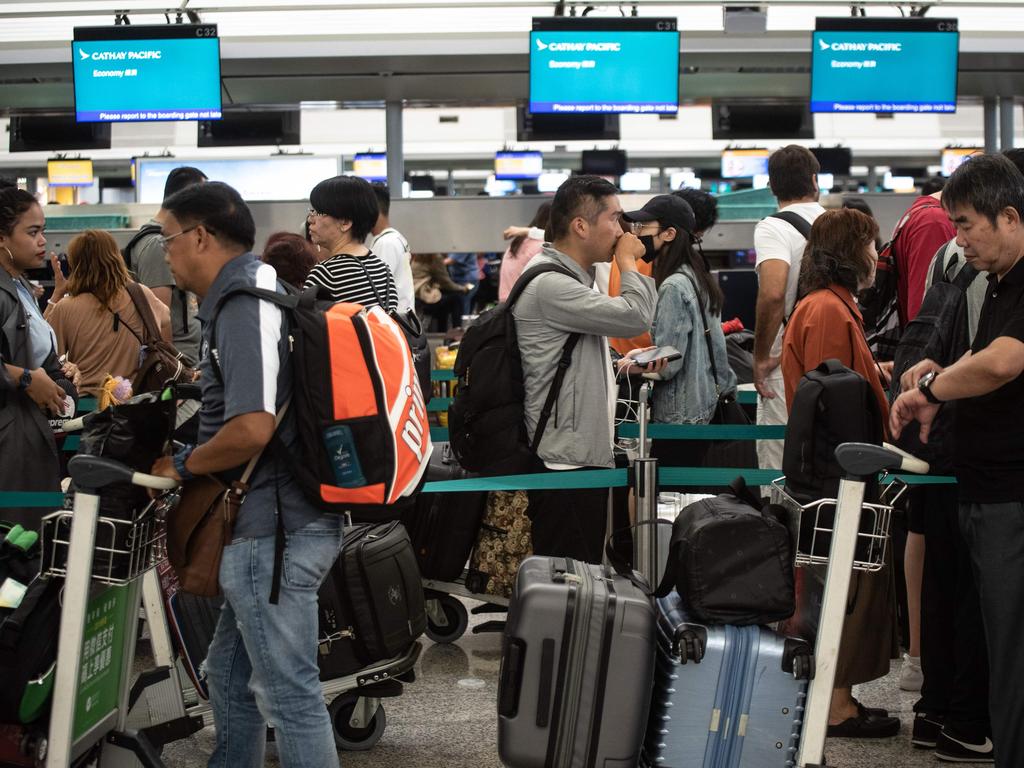


To join the conversation, please log in. Don't have an account? Register
Join the conversation, you are commenting as Logout